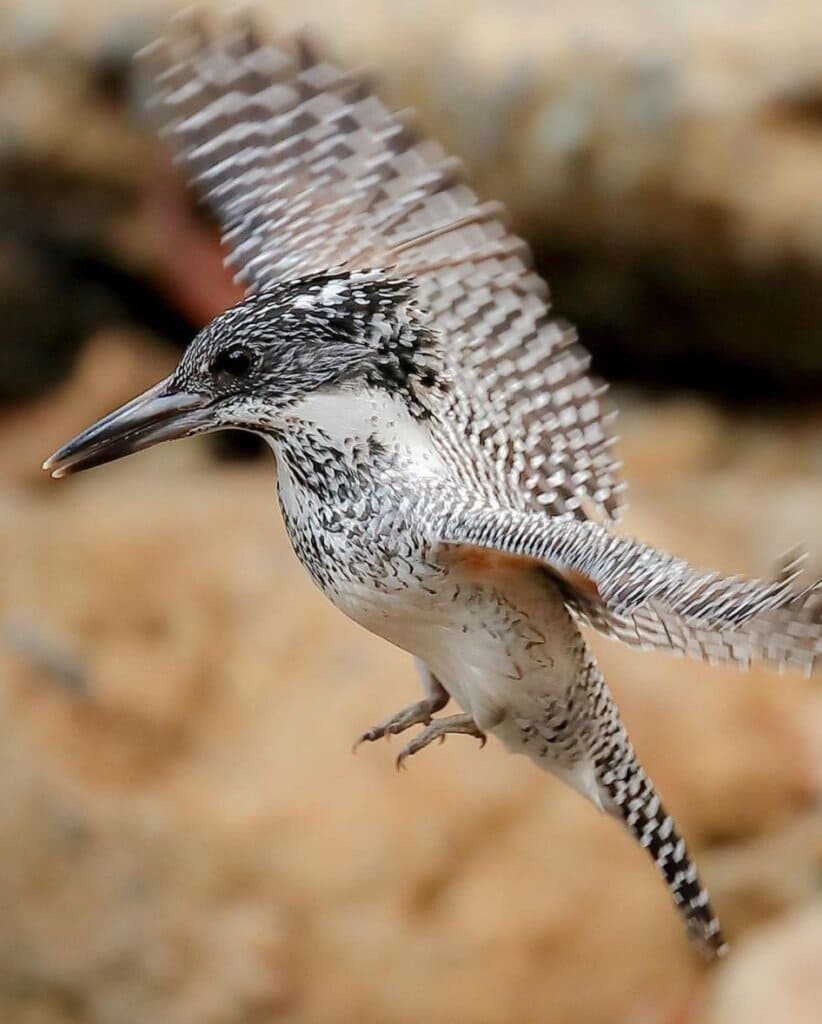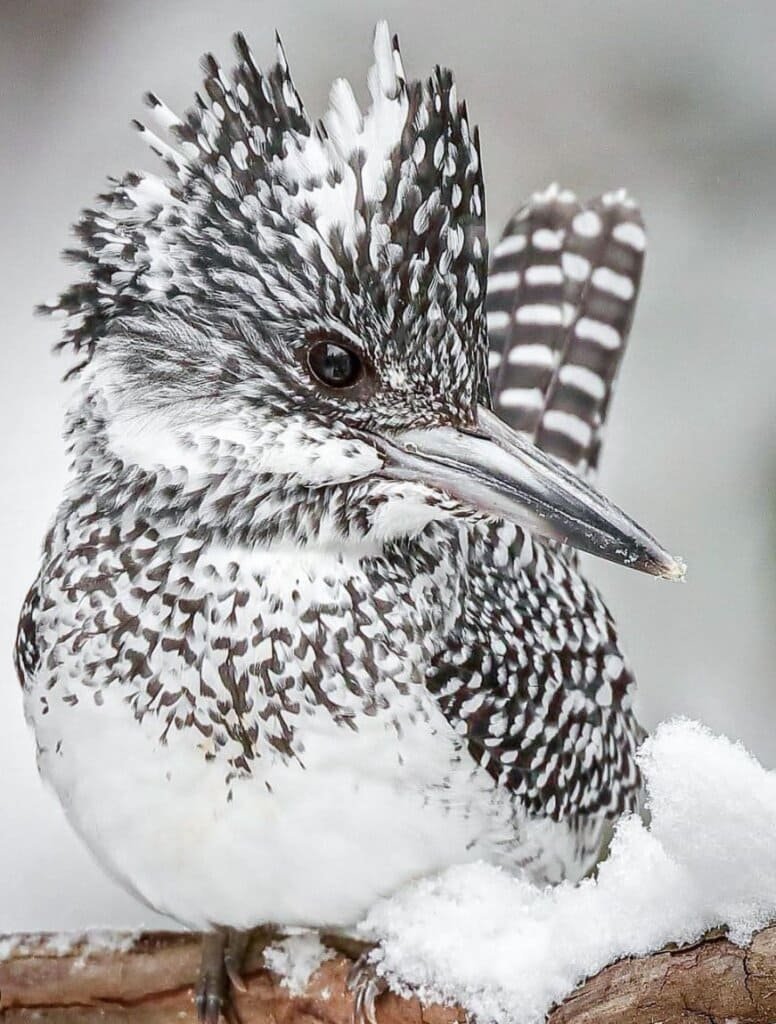The Crested Kingfisher (Megaceryle lugubris) is one of nature’s most striking birds, instantly recognizable by its distinctive black-and-white plumage and unique mohawk-like crest.
Native to parts of Southern Asia, this large kingfisher species captivates bird enthusiasts worldwide, not just for its striking appearance but also for its fascinating behaviors and habitats.
Whether you’re an avid birdwatcher or someone curious about the marvels of wildlife, the Crested Kingfisher stands out in the avian world, blending elegance with rugged, untamed beauty.

A Dazzling Appearance: The Crested Kingfisher’s Distinctive Look
With its prominent mohawk crest, the Crested Kingfisher truly commands attention. Its black-and-white feathers are flecked with stunning patterns, making it easily distinguishable from other bird species.
The bird’s shaggy, spiked crown of feathers resembles the trendy mohawk hairstyle, giving it an edgy, wild look that seems tailor-made for attention.
Its plumage is primarily white, adorned with black spots across the back and wings, creating a bold contrast that adds to its overall grandeur.
This mix of colors, combined with its large size compared to other kingfishers, makes the Crested Kingfisher an impressive sight, especially when it’s perched on a riverside branch, scouting for prey.
Male vs. Female: How to Spot the Difference
While both male and female Crested Kingfishers share the same striking plumage, there’s an easy way to differentiate between them: their chest feathers. Males are known for the striking orange feathers that scatter across their chests, creating a beautiful splash of color against the white and black.

In contrast, females lack these orange feathers, displaying a more uniform chest. This distinction can be helpful for birdwatchers keen on identifying the sex of the bird, adding an extra layer of fascination when observing them in the wild.
Habitat and Range: Where to Find the Crested Kingfisher
The Crested Kingfisher is native to the mountainous regions of Southern Asia, where it thrives in areas rich with rivers and streams. These birds are commonly found in countries such as India, Nepal, Bhutan, China, and Japan, often choosing habitats that offer both small and large rivers to hunt their prey.
Their preference for fast-flowing streams and rivers makes these regions ideal hunting grounds. Crested Kingfishers are typically seen perched on rocks or branches above the water, from where they scan for fish and crayfish—their primary sources of food.

This reliance on clean, fast-moving water also serves as an indicator of the health of their environment, making their presence a positive sign of ecological balance in their habitats.
Hunting Skills: The Crested Kingfisher’s Fishing Expertise
Crested Kingfishers are not only known for their striking looks but also for their impressive hunting skills. These birds are expert fishers, relying on their sharp vision and quick reflexes to catch prey.
Once a Crested Kingfisher spots its target, it dives into the water with remarkable speed and accuracy, using its long, pointed beak to snatch fish or crayfish.
Despite their large size, these birds are incredibly agile in the air, making them successful hunters even in fast-moving waters. After catching their prey, they often return to a nearby perch to devour their meal, providing birdwatchers with an incredible display of skill and precision.
Nesting Habits: Digging Burrows and Raising Chicks
Unlike many birds that nest in trees or bushes, the Crested Kingfisher prefers a more unconventional approach: digging burrows. These birds typically nest in vertical riverbanks, where they excavate deep burrows to lay their eggs. Both the male and female take part in digging, creating a safe environment for their future offspring.
Once the burrow is complete, the female lays 4-7 eggs, which she incubates while the male assists by foraging for food. The chicks are fully dependent on their parents during the first few weeks of life, with both the male and female working tirelessly to feed them.

After about 40 days, the chicks are ready to leave the nest and begin their own independent lives.
This unique nesting strategy not only protects the eggs from predators but also keeps the young chicks safe from flooding, which can be a risk in the bird’s riverine habitats.
The Role of the Crested Kingfisher in Its Ecosystem
The Crested Kingfisher plays an important role in the ecosystem of Southern Asia’s rivers and streams. As top predators in their habitat, they help maintain balance in the aquatic food chain by controlling populations of fish and crayfish.
Their hunting behaviors also provide benefits for the environment, as they often consume weak or sick individuals, preventing overpopulation and promoting the health of the fish species they prey upon.

Additionally, the presence of Crested Kingfishers is often an indicator of a healthy aquatic environment, as these birds are highly dependent on clean, fast-flowing water for their survival. Protecting these habitats not only supports the kingfishers but also ensures the preservation of biodiversity in these fragile ecosystems.
Conservation Status and Efforts
Though not currently considered endangered, the Crested Kingfisher faces potential threats from habitat loss due to deforestation and water pollution. As rivers and streams in Southern Asia become more polluted or altered by human activity, the kingfisher’s hunting grounds are increasingly at risk.
Conservation efforts aimed at protecting these birds focus on preserving their natural habitats and ensuring that the rivers and streams they rely on remain clean and undisturbed.
By promoting sustainable practices and raising awareness about the importance of river conservation, we can help protect the Crested Kingfisher and other species that depend on these waterways for survival.

Conclusion:
The Crested Kingfisher is more than just a bird with a wild mohawk—it’s a fascinating creature that plays a crucial role in its ecosystem. From its stunning appearance to its expert hunting skills and unique nesting habits, this bird captivates anyone lucky enough to observe it.
As we continue to protect the natural habitats of Southern Asia, ensuring that rivers and streams remain pristine, we can look forward to many more generations of Crested Kingfishers gracing the skies and rivers with their beauty and skill.








